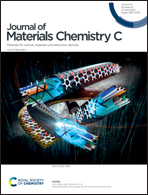Z-Scheme photocatalytic solar-energy-to-hydrogen conversion driven by the HfS2/SiSe heterostructure†
Abstract
The feasibility and efficiency of photocatalytic solar-energy-to-hydrogen conversion via a direct Z-scheme driven by a HfS2/SiSe heterostructure are investigated by employing first-principles hybrid functional theory. Nine configurations consisting of HfS2 and SiSe monolayers with different stacking models are considered, and the three with larger formation energies are chosen for further investigation. The results demonstrate that the band alignment and built-in electric field make the configurations suitable for use in the direct Z-scheme for the photocatalytic hydrogen evolution reaction upon solar light irradiation. The optical absorption and carrier mobility of the monolayers are used to understand the photoelectronic performance, and the effects of strain on the photocatalytic properties are examined. Tensile biaxial strain can promote performance while compressive strain decreases the solar-energy-to-hydrogen conversion efficiency in the considered range from −3% to +4%, and the maximum solar-energy-to-hydrogen conversion efficiency can reach 9.56–11.48% for these configurations under +4% strain, indicating that the HfS2/SiSe heterostructure is a promising candidate for use in photocatalytic solar-energy-to-hydrogen conversion.



 Please wait while we load your content...
Please wait while we load your content...